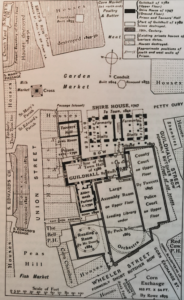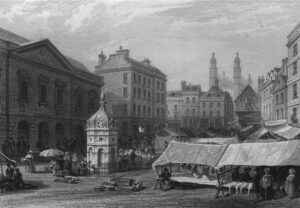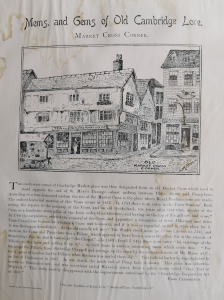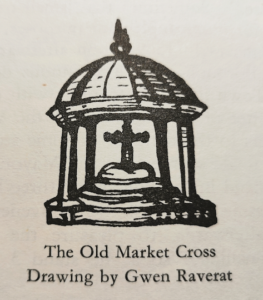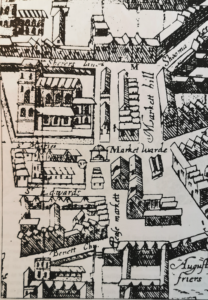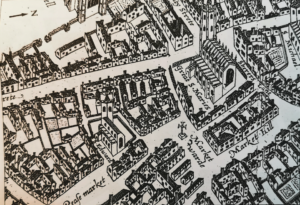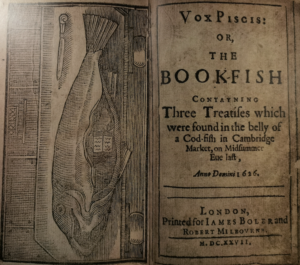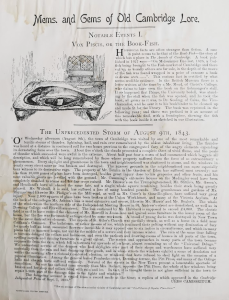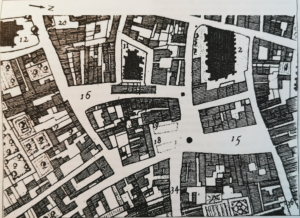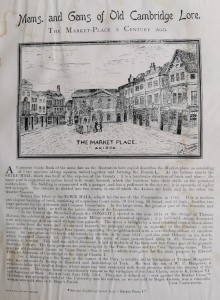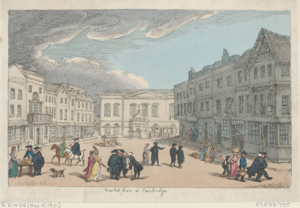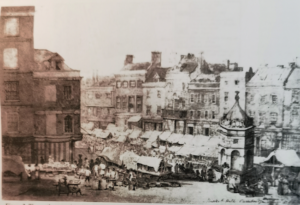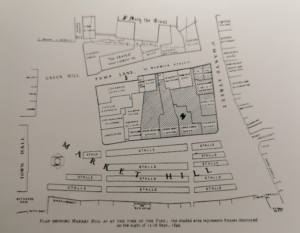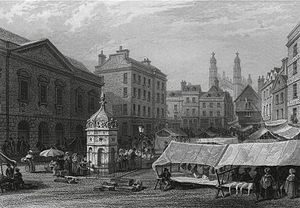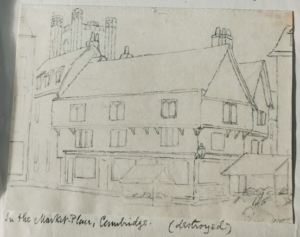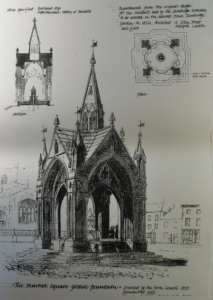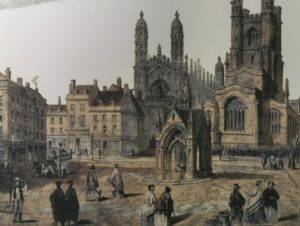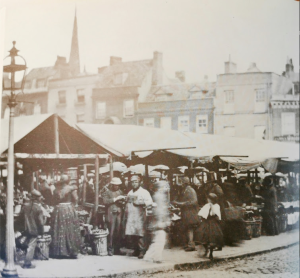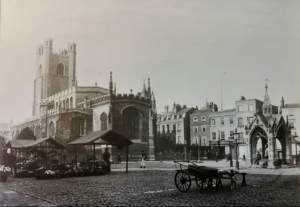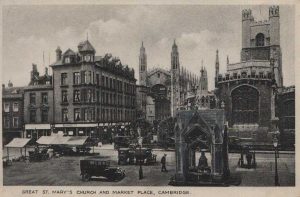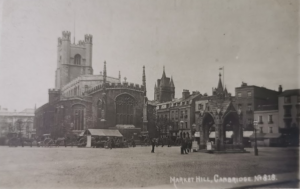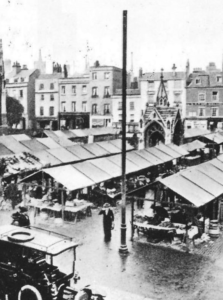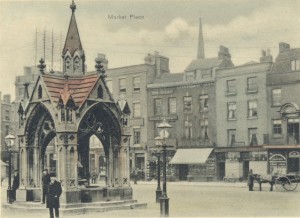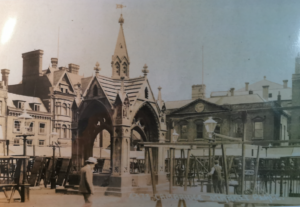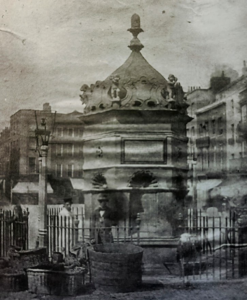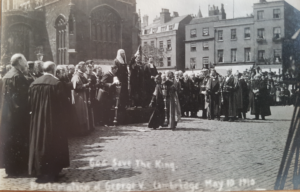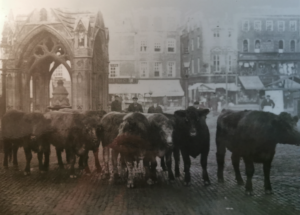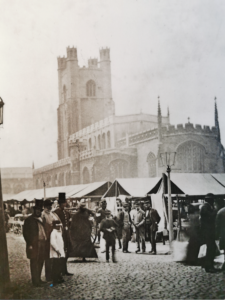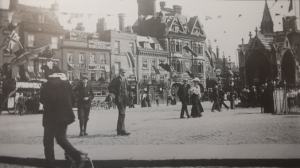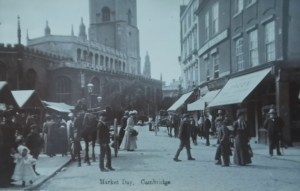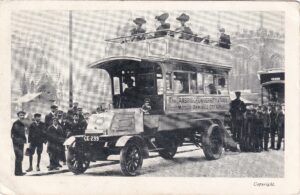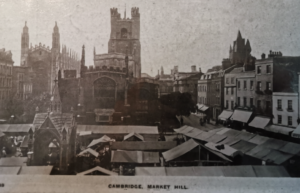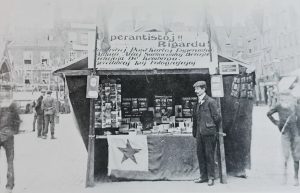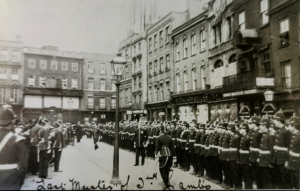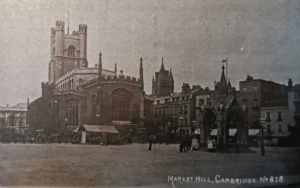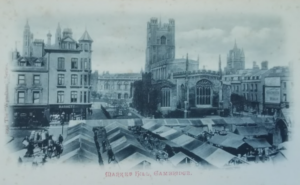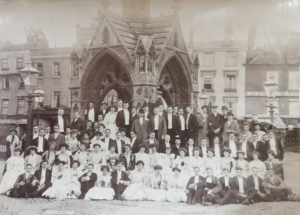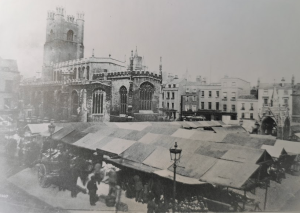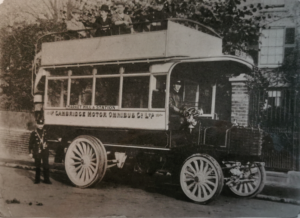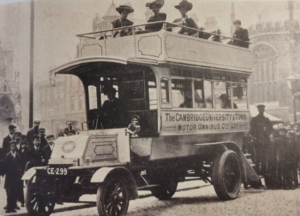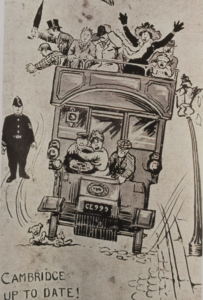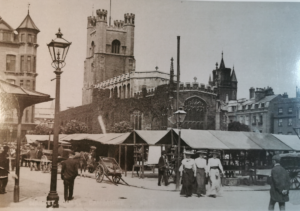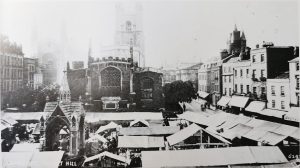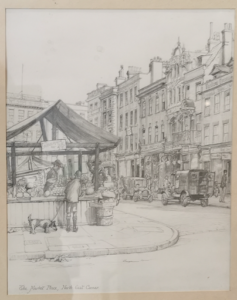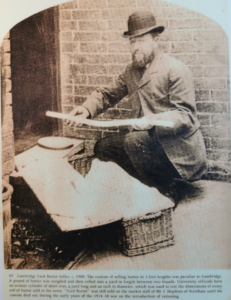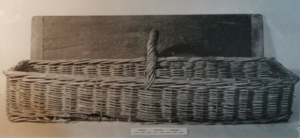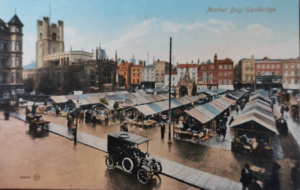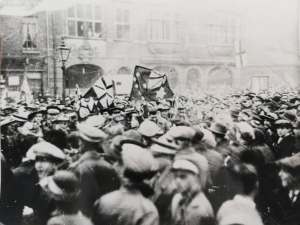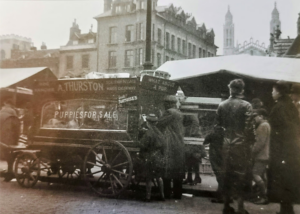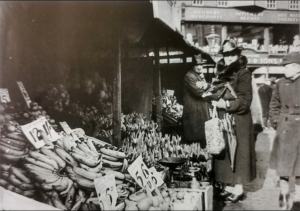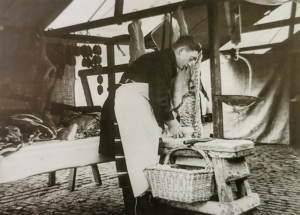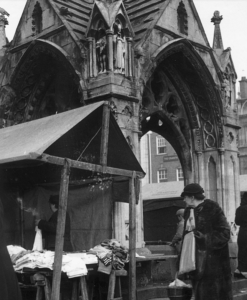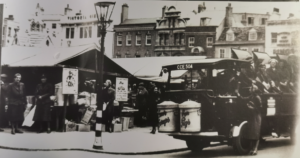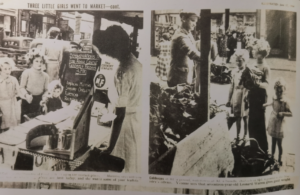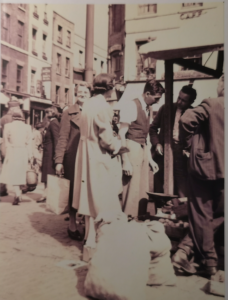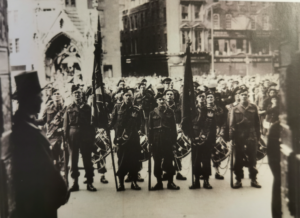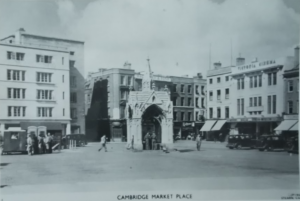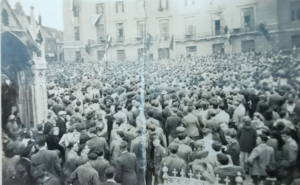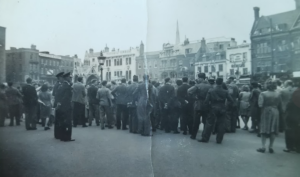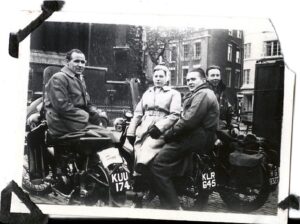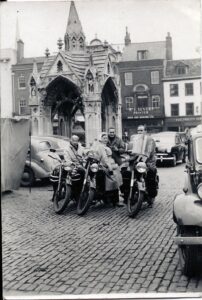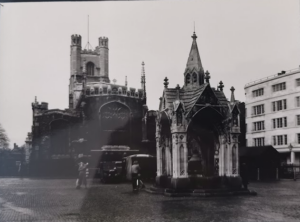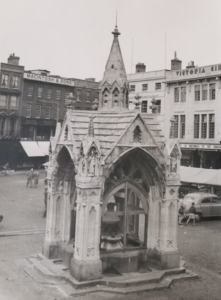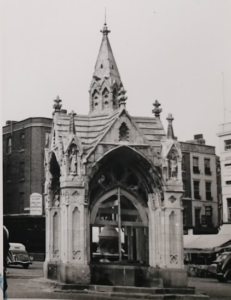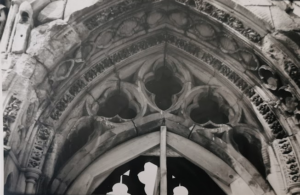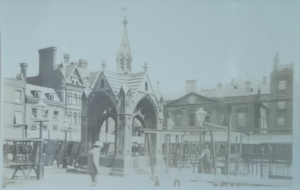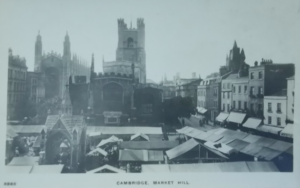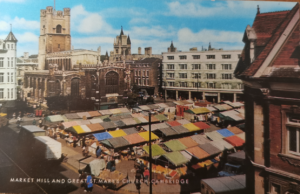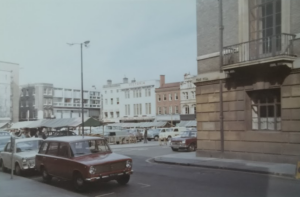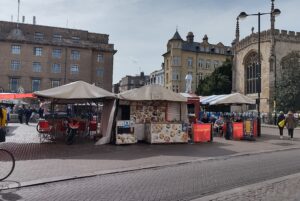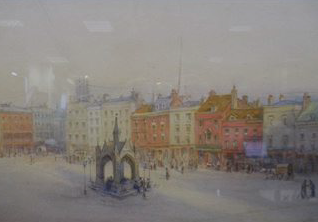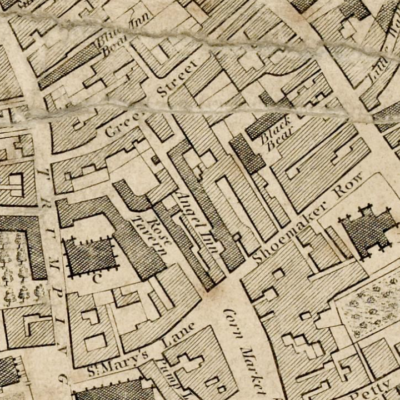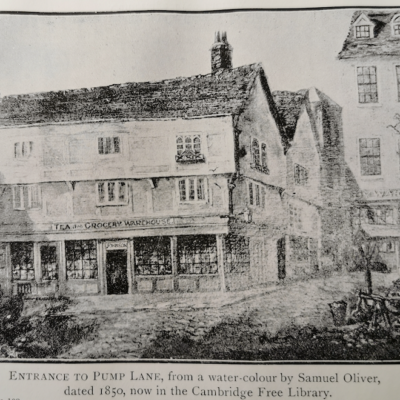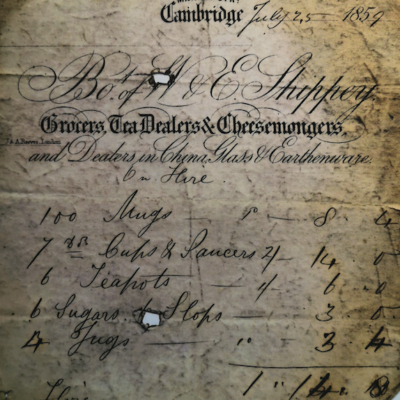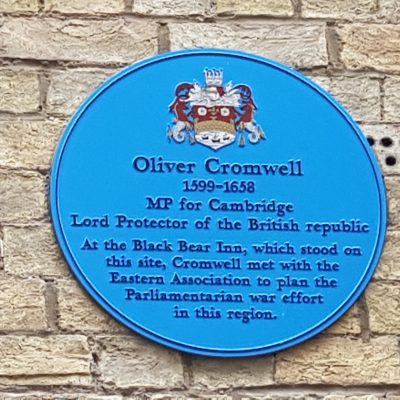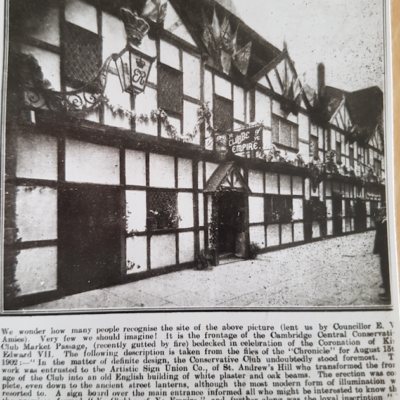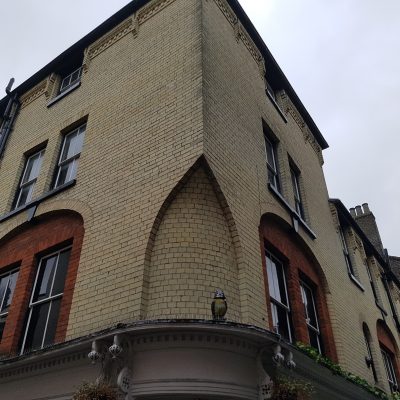Search by topic
- archaeology
- Building of Local Interest
- chapel
- charity
- church
- crime
- dressmaker
- fire
- Great Eastern Railway
- Listed building
- Mapping Relief
- medieval
- oral history
- poverty
- Public House
- Religious House
- Roman
- scholar
- school
- Then and Now
- tudor
- women
- work
- world war one
- world war two
Search by text
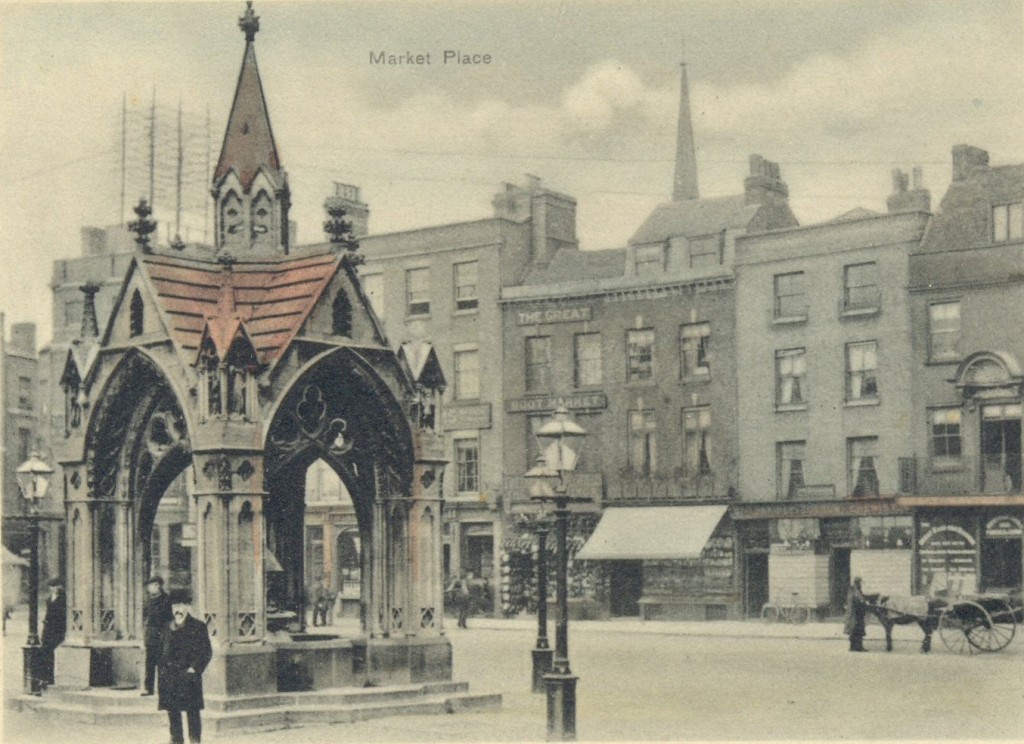 Market Square, Market Hill, Cambridge
Market Square, Market Hill, CambridgeMarket Hill, Cambridge
History of Market Hill
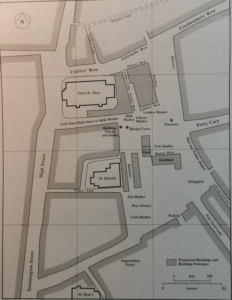
Central market area in Cambridge in the medieval period from Proceedings of the Cambridge Antiquarian Soc Vol XCI 2002: A Reconstruction of the medieval Cambridge Market Place – Peter Bryan and Nick Wise
The article by Peter Bryan and Nick Wise, ‘A Reconstruction of the Medieval Cambridge Market Place’, proceedings of the Cambridge Antiquarian Society 2002, presents an in depth study of the development of the historic market place. The article includes the map shown above. The features shown which are described in detail in the article are: The Bull Ring, Butchery, Butter Row, Cheese Market, Combers lane, Cordwainers’ Row, Corn Market, Cutlers’ Row, Cutlers’ lane, Fair Yard Lane, Goldsmiths’ Row, Leathermarket, Malt Market, Milk Market, Oat Market [used in pottage for the poor], Peasmarket [peas were a staple food of the poor], Potters Row, Poultry Row, Saddlers’ Row, Shraggery [timber market], Smiths’ Row [mainly iron mongers], Spicery, Tripers’ Lane.
There are also market activities whose location is unknown: Apothecaries Row [possibly in the area of Rose Crescent], Cloth Market, Lorimers’ Row [makers of harness], Smeremongers’ Row [sellers of tallow].
See also Enid Porter’s article:
Also, F A Keynes ‘By-ways of Cambridge History,’ chapter 1 – The Guildhall and the Market Place.
1841 engraving of the Cambridge market place entitled “The Market Place, Shewing The Town Hall & Hobson’s Conduit” by John Le Keux from a drawing by Frederick Mackenzie, and published by David Bogue, London.
The medieval market place was much larger than that of the late 19th century. The southern part of the old market place gradually became occupied by municipal buildings.
From the early 13th century houses houses surrounded the eastern end of Great St Mary’s church. They were separated from a much larger block of shop-houses by a street known originally as Smith’s Row, later recorded as Combers Lane and Well Lane. These were shop houses shown on the sketch plan by John Botwright which dates from the 15th century.
The medieval market in Cambridge would have consisted partly of temporary stalls or booths and partly of permanent shop-houses facing onto the open spaces of the market. Documentary evidence exists to show that the floor of the market was paved with sand, which was absorbent, and easily levelled and renewed.
Market tables were not permanent and had to be hired from the ‘Treasueres.’ This was designed to prevent ‘foreigners’ from slipping into the market. Butchers could trade from shops and have their own trestle tables, which were not hired on market days.
The northern end of the market contained activities of a higher-class nature such as the Spicery, the Goldsmiths, Cutler and Lorimers. The southern end of the market may have been more concerned with foodstuffs.
1382
There was a riot led by James de Grantchester, allegedly at the connivance of the mayor, where an armed mob pillaged the common chest of the University and burned the documents in a bonfire.
1467
1529
The Mayor was excommunicated by the Vice-Chancellor for refusing to answer a charge of having violated the privileges of the University and the document of excommunication was affixed to the market cross. (F A Keynes 1956)
1553
The Duke of Northumberland in support of Lady Jane Grey, arrived in Cambridge with a large force. Mary Tudor was then at Framlingham in Suffolk. When the Duke found his forces deserting him, “he came to the market crosse of the towne and calling for an Herault, himself proclaimed queene Mary, and among other he threwe up his own cappe.” Even so, that evening he was taken from Cambridge to the Tower of London and was beheaded ten days later. (Keynes 1956)
1557
6th January: The Papal legate, Cardinal Pole sent a number of clergy to visit the university to re-establish the catholic religion more completely. They ordered that the bodies of the two German theologians, Martin Bucer and Paul Fagius, be exhumed from Gt St Mary’s and St Michael’s churches and publicly burned. On the morning on 6th January the two corpses were carried in coffins and bound by chains to a tall post. A great pile of wood was set alight beneath the coffins.
1564
The Market Cross was repainted and the lead mended in preparation for the visit of Elizabeth I
1569
A student was nailed by the ear to the pillory at the Market Cross by order of Lord North, the Lord Lieutenant, for having used “evyll and fowle wordes” to the Mayor.
John Hamon’s map is the first accurately measured and detailed map of the town.
1593
Almost 2200lb of lead was taken from the Cross and sold; this was when the canopy was removed.
By 1660 only the step and shaft of the market Cross remained.
1626
The strange tale of the Book-fish, Vox Piscis
See also Peas Hill.
1660
The Diary of Samuel Newton 1662-1717 (pub.1890):
On Fryday the 11th May 1660 King Charles the Second was proclaymed King by John Ewin Chadler then Maior of Cambridge. The Maior himselfe read the Proclamacion, the Towne Claerke more audibly spoke it after him;
With the Maior, was the Recorder in his Gowne, and all the Aldermen in their Scarlet Gownes on horseback, and all the freemen on horseback. They procalimed twice (in 2 severall places) in the great Markett Place
once on the Pease hill
and against St Buttolphs Church
and beyond the Great Bridge
and against Jesus Lane
and against Trinity Church
In all these places was Hee proclaymed, at night many bonfires in Towne, 4, on the great market Hill …….
1664
The old Cross disappeared and was replaced by one totally different.
When Samuel Newton was town treasurer in 1664 on 1st October he had to collect 1d from every butcher’s and fish stall in the market. He collected 9s 3d, which is the equivalent of 111 stalls.
1688
Alderman Newton recorded in his diary, 18th February, the ceremony of proclamation of William III and Queen Mary:
… the Maior and Aldermen arrived in Scarlett on horseback and the Common Counsill on horseback in their Gownes with many that had past offices and other Freeman, first they were proclaimed at the Market Crosse, 2ly on the market place on the Hill neare the Rose Taverne,…
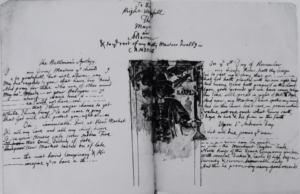
Bellman’s verses 17th Centruy (Bodleian Library Gough-Cambs 103/8). In the middle there is a sketch of the Bell Man and his name, Saul.
The Bellman’s verses refer to a fire in the New Market.
1786
The old Market Cross was destroyed although the location was still used for proclamations.
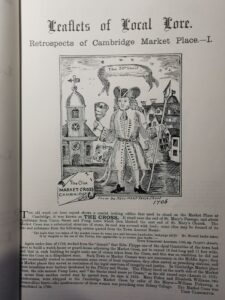
Retrospects of Cambridge Market Place I, from Leaflets of Local Lore by Urbs Camboritum (Cambs Collection)
1798
1841 Market Hill (zone partly destroyed in 1849 fire and subsequently demolished)
Charles Orridge, 55, chemist
Robert, 18
Frederick, 13
Fanny, 20
Ann Morris, 20, servant
Susan Stamford, 18, servant
John Knight, 35, servant
Elizabeth Bridge. 20, independent
Rebecca Wonfor, 45, servant
James Healey, 35, hatter
Jane, 30
James, 4
Lucy, 2
Lucy Townsend, 20, servant
Emily Harvey, 15, servant
Daniel Hubbard, 35, draper
Mary, 30
Mary, 5
Daniel, 3
Rosa, 2
Catherine, 1
Henry Kent, 24, servant
William Goodliff, 24, servant
Thomas Wells, 20, servant
Henry Fletcher, 18, servant
Thomas Wrench, 17, servant
Sarah Giblin, 21, straw bonnet maker
E Morley, 25, straw bonnet maker
Elizabeth Stittle, 27, servant
Charles Thompson, servant
Thomas Willson, 53, silversmith
Eliza Coates, 40, servant
Ann Sizer, 18, servant
George Lesturgeon, 30, surgeon
Elizabeth, 25
Ann, 20
Sarah, 15
Emma, 14
Jacobina, 10
Carolina Harman, 20, servant
Jane Goates, 15, servant
Ann Trundle, 30, milliner
Hercule Sharp, 19, independent
Honeywood Scott, 20, independent
Sarah Satchell, 20, milliner
Jan Collier, 15, milliner
Susan Binsted, 28, servant
Frederick Styles, 40, fishmonger
Ann, 40
William Brown, 20, servant
Sarah Castle, 15, servant
James Sharman, 36, toy man
Sarah, 35
James, 5
Sarah, 4
James Stewart, 21, independent
Mortimer Buckley, 22, independent
Emma Newman, 18, servant
1846
On the evening of Saturday 21 February 1846 a devastating fire started in the Headly foundry which destroyed part of Market Hill. It was report in the Cambridge Chronicle on 28th February.
Before 1849 the market stretched from Petty Cury to Peas Hill in an L-shape. But such was the damage in the Great Fire of Cambridge (15-16 September 1849) that destroyed and damaged many houses on Market Hill that the whole area was cleared and by 1855 had become the modern large open rectangle. (from 111 Places in Cambridge That You Shouldn’t Miss pub. Emons). The shaded area in the map shows the buildings destroyed.
Josiah Chater described the fire in his diary. He had been awakened by Miss Aikin on the morning of 16th September who told him there was a fire somewhere:
I immediately jumped out of bed and looked out of the window and thought it appeared to be near Mill Lane. I dressed very hastily and bundled downstairs when, to my horror, I found it was on Market Hill at Lodge’s next door to Orridge the chemist. I ran at once to the engine and began pumping, then handed the bucket for a long time. ….. the fire raged until about 6 o’clock and burned down 8 houses and seriously damaged several more, all tradesmen’s. … I must confess though, that while it was burning it was a glorious sight, and when the chemist’s was on fire, every time a bottle cracked there was an explosion superior to fireworks.
On Monday 17th September Josiah recorded: there has been an inquest held at the Town Hall on the fire, and it is adjourned to tomorrow at 6 o’clock.
There were allegations that Mr Lodge, the clothier on whose premises the fire had started, had deliberately caused it because he was in financial straits. When he heard these rumours, he served writs for scandal on a number of people. The verdict was that the fire had started at Lodge’s but there was no evidence of its origin.
Romilly records the fire in his diary entry of 16th September: An awful fire on the marketplace broke out at quarter past twelve last night and has destroyed 8 houses. Lucy and I went to see the smouldering ruins just before church. I never saw more complete destruction, the outside walls have all gone; they must have been mrer lath and plaster. Lucy staid looking on until near the end of the Litany: I went in for the beginning of the service.
The properties listed in the central block affected by the fire, clockwise from top left are:
J Sharman, toy dealer
?
S A Keemish, tailor
W White, bootmakers
“Kings Head”, D Pate
unoccupied
James ?
R Moden and son, oil and colourmen
James Mulligan, tailor
Charles Orridge, chemist
James Lodge, hosier
Henry Kent, hatter
Joseph Pearless, draper
Thomas Wilson, silversmith
A K Spink, tailor and Miss Menge, milliner
unoccupied
Mdms Young and Ingle, milliners
F Styles, fishmonger
http://cambridgehistorian.blogspot.com/2012/12/the-great-fire-of-cambridge.html
At the centre of the Market lie the remains of G M Hills’s Gothic conduit of 1855. The original structure of Hobson’s conduit was moved then to the corner of Lensfield and Trumpington Road in 1856. Hill’s conduit was mostly demolished in 1953 and the water supply cut off in 1960.
The pinnacles are now in the Museum of Cambridge. In their niches stand carved figures of Cambridge men:
Sir John of Cambridge, Justice of the Common Pleas
Sir John Cheke, who revived the study of Greek in the University after the departure of Erasmus
Thomas Thirleby, Bishop of Ely
Godfrey Goldsborough, Bishop of Gloucester
Orlando Gibbons, composer who entered King’s College choir in 1596
Thomas Hobson, famous carrier
Jeremy Taylor, author who became Bishop of Down and is reputed to have been born in the Wrestlers Inn in Petty Cury.
This is a picture from 1840 of the original conduit which was moved in 1856. The illustration is ‘Market Place. by Fredrick Mackensie from the FitzWilliam Museum. The buildings on the right which obscure Great St Mary’s were destroyed in 1849 by the Great Fire .
Moule may have drawn this detail from memory after the fire of 1849.
1855 A new Conduit is designed.
Here are views of the later Gothic style conduit.
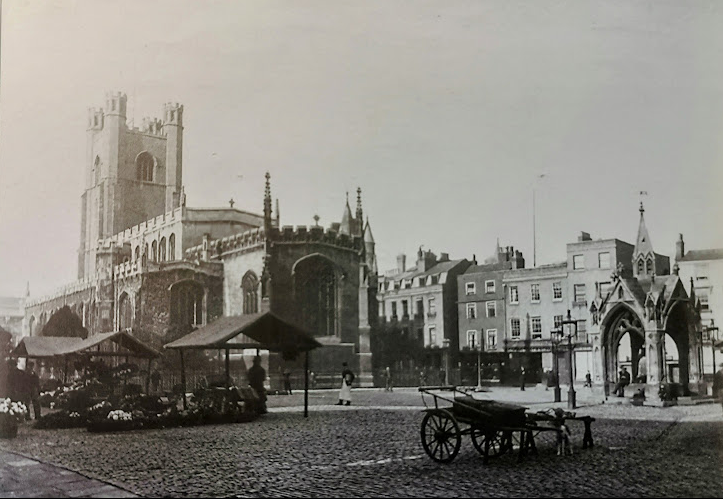
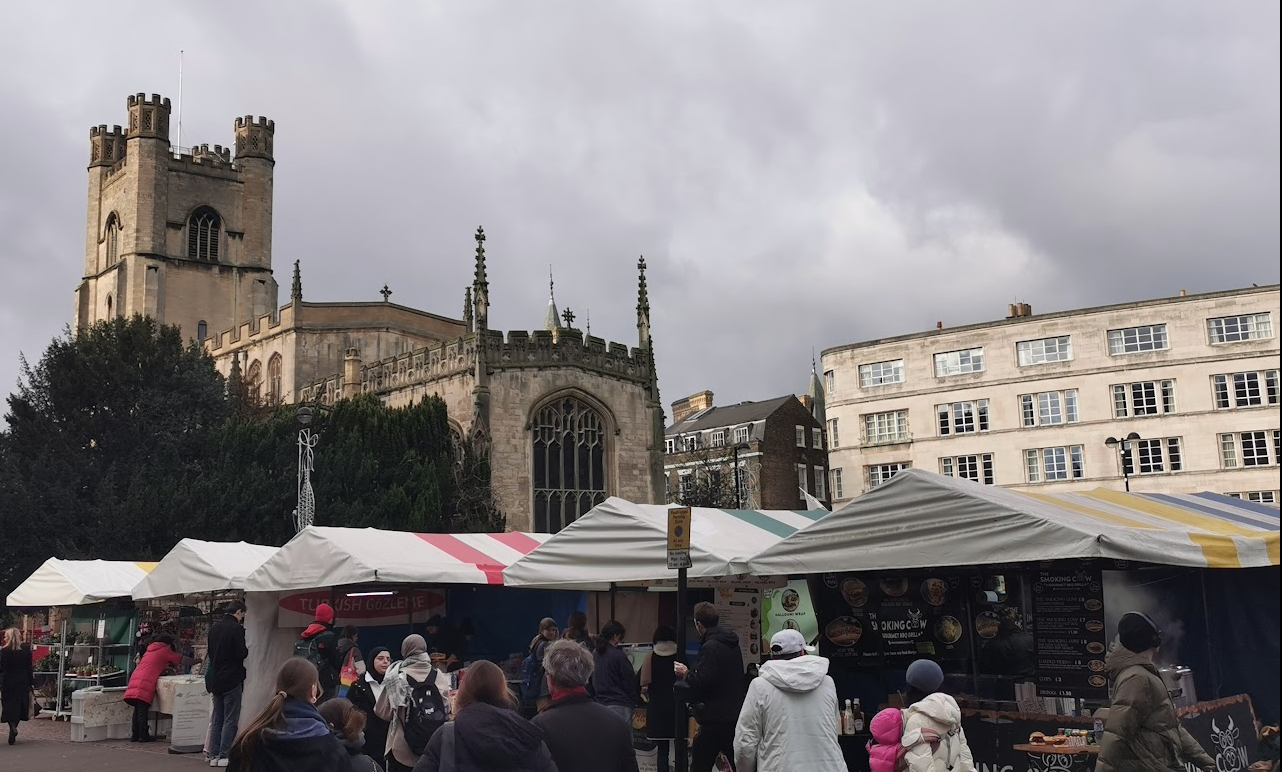
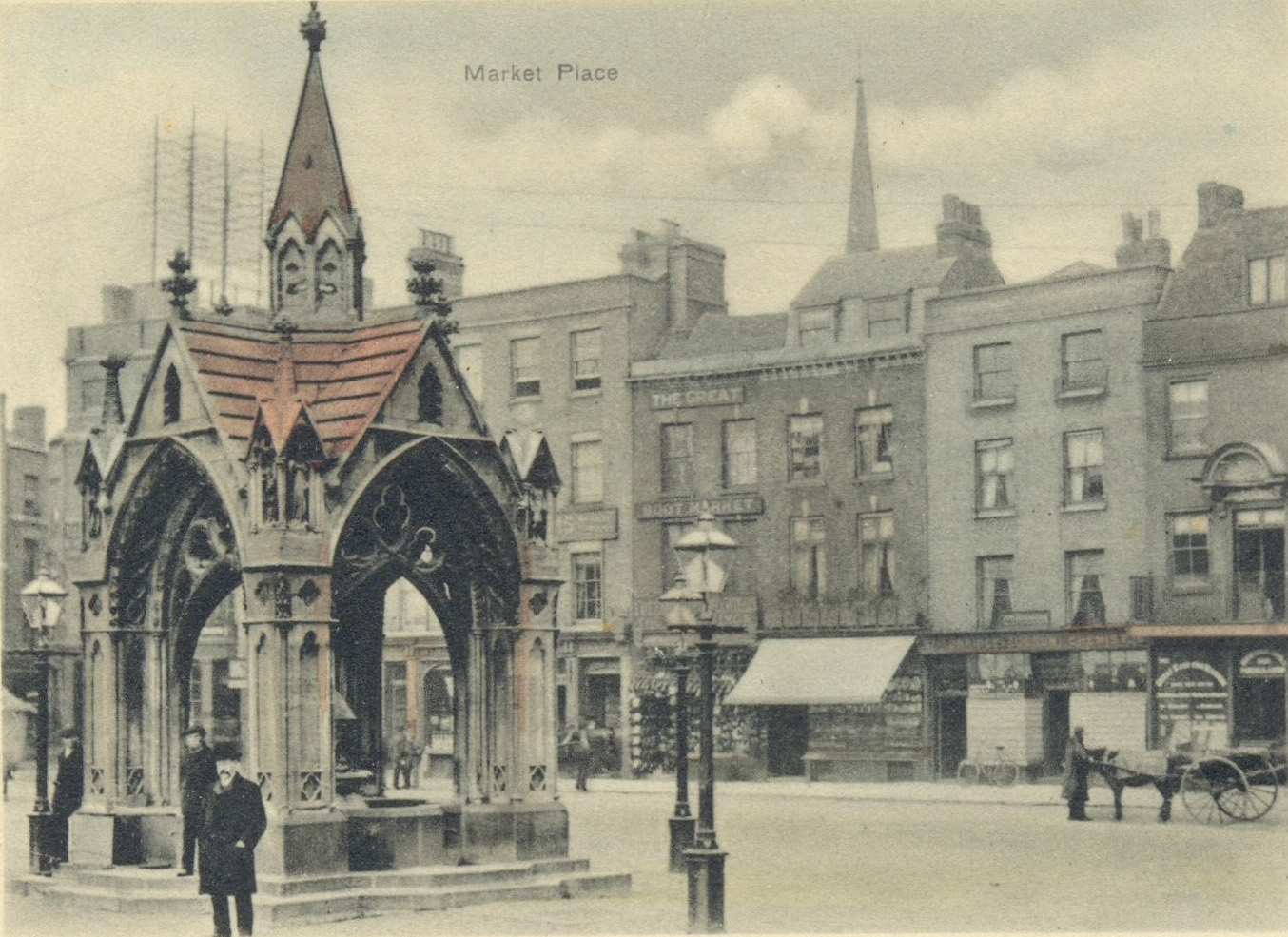
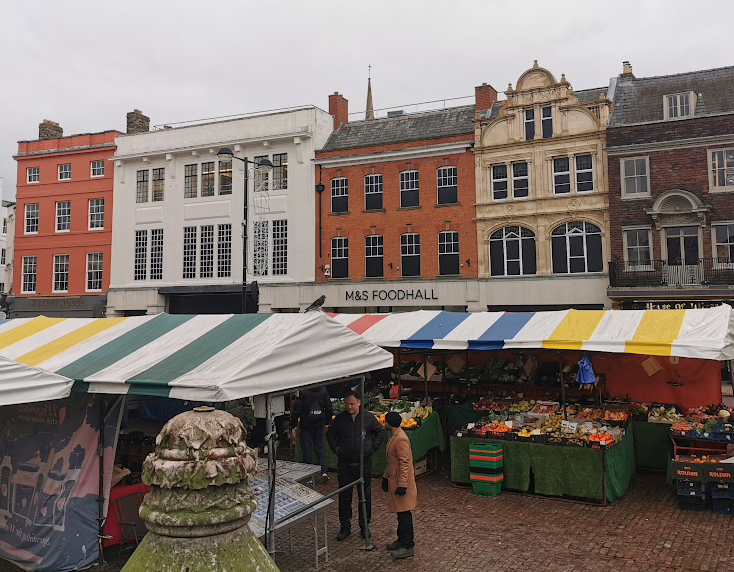
These are bullocks bought by Nichols whose butchers’ shop was at the corner of Petty Cury, on the Market Square and about to be taken to a slaughterhouse.
24/4/1897 A memorial from certain inhabitants of the Cambridge in Favour of covering the Market Hill with a permanent covering of iron and glass was read by the Town Clerk. Coun Nichols thought the state of their present market was a disgrace to civilisation. They were paying at least £400 a year for putting up and taking down those wretched wooden structures and the cloths that covered them were of no use whatever. Mr F. Morley did not believe in the Corporation entering into competition with the shopkeepers of the town and driving the trade into the hand of people who paid no rates. Mr Campkin felt the question of a covered market elsewhere was too serious a matter for them to consider for many years to come. (The council voted against the proposal) (Cam.News)
Councillors vote against turning Market Hill into a covered market. 1897.
21/5/1897 After the Senate House scenes yesterday (when the University voted against degrees for women) there was a brief respite. It was the calm before the storm. About 7 o’clock there was a grand gathering of the clans. Undergraduates began trooping through the streets to what was obviously a pre-arranged rendezvous – the Market Hill. From the four corners of the square fire was opened upon everybody and everything within range. Bombs, hand-rockets, and every description of firework manufactured were flung haphazard into the crowd until the scene resembled nothing so much as the bombardment of a hostile camp. It is no exaggeration to say that hundreds of pounds worth of stuff were got rid of during the five hours the proceedings lasted (Cam News)
23/6/1897 Providence set the seal of approval on the absolutely flawless celebration of Queen Victoria’s Jubilee. Cambridge Market-place presented a particularly attractive spectacle with the Guildhall illuminated and the long lines of coloured lamps; above all with the moving masses of eager folk, who had come out in the best of tempers to be amused. One or two cranky people pretended to be shocked at the extreme naughtiness of letting off a few squibs, which was not to be compared with the imprudence of running heavy ‘busses through the narrow and crowded Cury and Market-hill. A remarkably beautiful sunset was succeeded by the exquisite Jubilee twilight mingling into the dawn of the longest day; and in Cambridge, as elsewhere, everybody who went to bed – and most folks sought that sensible repose – did so with high hopes of the morrow (Cam.News)
11/12/1897 Cambridge Market Committee recommended that a new form of market stall known as the “Diamond Stall” be erected on Market Hill. Mr Nichols remarked that the long vexed question of covering in the market was the objection to a permanent structure being erected on Market Hill. They were paying now £850 per year for putting up and taking down all those wretched stalls and their repairs. At some length he described the advantages to the town that the scheme would bring about, amid some manifestations of impatience on the part of the Council (Cam.News)
19/5/1898 Cambridge town council was requested to consider permitting a cabmen’s shelter to be placed on the Market Hill. Mr Darwin said that he received a petition asking for the provision of some place for them to warm themselves during the cold months in some central position in the town. At present there was only one cabmen’s shelter in the town and that was very widely used. If they provided another the public would gain some advantage because the cabmen, instead of going to the public houses, as they now did, would go to the shelter. The only possible harm it would do was that perhaps it would make the neighbouring public houses sell less beer (Cam.News)
7/11/1898 Saturday was a typical “fifth” in Cambridge. Faithfully following the precedent set in former years a number of Varsity men and townspeople assembled in the market place, which for three hours or so was crowded with excitable and pugilistically-inclined youths, representing town and gown. The Gown driven from pillar to post by the howling mob, appeared to be greatly terrified, and despite the vigilance of the police, of whom a large number were told off for special duty, the celebration was not entirely free from violence. Neither town nor gown missed many opportunities of displaying their physical prowess and many are the reports circulated as to the results of the pugilistic encounters that ensued (Cam.News)
6/11/1899 The announcement that a number of Reserve men belonging to the Suffolk Regiment would leave Cambridge to join the regiment sufficed to bring thousands of people together in the Market Hill to give them a hearty send off. It detracted somewhat from the picturesqueness of the effect that the Reserve men were not in uniform but in their ordinary clothes but they could not have evoked greater enthusiasm on the part of the public. Heads of colleges were there, undergraduates in caps and gowns rubbed shoulders with farm workers form the country. Old soldiers wearing their medals had come to live over again stirring scenes from their youth. Women were there and children also. It was a crowd thoroughly resolved upon manifesting its goodwill to the men who were going away (Cam.News)
1/3/1900 The greatest possible excitement followed the receipt of the news of the relief of Ladysmith. The telegrams conveying the announcement was received at the chief Post office shortly after 10 o’clock and the intelligence spread with marvellous rapidity to all parts of the town. When a private wire was posted in the Market Place the excitement was intense. From all approaches people could be seen rushing to get a view of the telegram and the wildest enthusiasm prevailed. The crowd raised hearty cheers and there was much waving of hats and handkerchiefs. (Cam.News)
3/3/1900 There was great rejoicings in Cambridge on the relief of Ladysmith and despite the edict sent forth by the University authorities the conduct of the undergraduate element was again such as to necessitate the intervention of the police. The Varsitymen managed to draw police attention off the market place to scenes elsewhere and, during their temporary absence, succeeded in lighting a bonfire. There was great excitement as one by one the wooden frameworks of the stalls was committed to the flames. The band-stand on Christ’s Pieces was attacked and the seats removed to the Market and quickly consumed. Similar damage was occasioned in all parts of the town. It was on that night that the last really big bonfire was started on Cambridge Market Square. Old horse buses, “growlers” filled with tar and straw, market stalls – all went to feed those triumphant flames whose heat cracked every window in the Market Square. (Cam.News)
13.7.1901: What say the shareholders of the Cambridge Tramways Company to the advent of a new service of motor buses working only from Market Hill to the Station – a penny service running from 8.30am to 9.30 pm. 1 have been assured by one of the promoters that the first of a batch of six new motor ‘buses intended to be used on the new smooth road from the Post Office to the station will be tried in Cambridge within a month. It is certain such rivalry would destroy the present useful and satisfactory tram service. (Cam.Press)
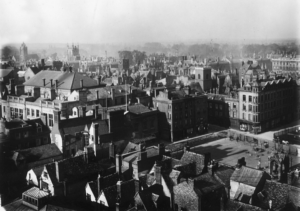
Market Hill, south end, with Corn Exchange roof visible. 1901 photo by H pain (Mike Petty Fenland History)
11.11.1901: It being the King’s 60th birthday it was expected that nightfall would be the occasion for rowdyism and possible an attempt to illuminate Cambridge Market Hill. The authorities cleared away the stalls, but their action left the historic centre of all “rags” open and free for the antics of the crowd. For a long time nothing occurred except the explosion of a few crackers or the discharge of a pistol from a window overlooking the hill. Large numbers of police were hustled about considerably, and were compelled to defend themselves, but compared with other ‘rags’, they did not have to exert themselves very much. It was a very tame, spiritless affair that will doubtless be deemed by the “bloods” to have been a complete failure, considering that practically no damage to property was done (Cam.Press)
3.6.1902: Peace in South Africa produced strife in Cambridge – one of those fierce contests between the police and the united forces of town and gown which, combined with the destruction of property, constitutes a “rag”. In King Street a large double gate was attacked as wood for a bonfire but a vigorous-looking dame appeared from the other side. Her only weapon was a duster, but such a formidable appearance did she present that the crowd melted away before her advance. Skirmishers went towards the Circus of Varieties to obtain a hoarding but this was well guarded and soon they were retracing their steps. The hoarding which surrounded the underground toilets on Market Hill was tom down and lighted. More wood was wanted and the mob pulled down glazed bricks and girders, door-posts and window frames. Next morning the appearance of the projected underground lavatory was more like an archaeological excavation. Thousands of bricks were lying in the bottom mixed up with the dirt and pieces of wood and the general appearance of the place showed how wanton and reckless had been the young hot heads who had wrought the damage (Cam.News)
26/8/1903 A meeting arranged by the Cambridge Anti-Vaccination League was held on Market Hill. A large crowd of people assembled but the opinions of the principal speaker aroused some opposition & a little heckling took place. Someone placed a quantity of calcium carbide into the water of the fountain. & the acetylene gas which was generated was borne among the audience to whom the disagreeable odour was most objectionable (Cam.News)
15/4/1905 Both Cambridge buses started to ply for hire and the novelty induced people to make trips. Had several more ‘buses been running they would have been crowded. The scene on Market Hill was unprecedented. Apart from those who lined one pavement in the hope of obtaining a seat it was alive with folk who were content with watching. As soon as a vehicle drew up a crowd swarmed around the steps, clutching the handrail and endeavouring to get a foothold on the step. Each time there were many left waiting on the pavement disappointed and most waited until it returned. (Cam.News)
On the 15th April 1905, two companies began the first motor bus service in the city. Not only were they in competition with each other, but also with the tramway service. The Cambridge University and Town Motor Omnibus Company Ltd ran a 25 horse powered light blue liveried Straker Squire – registered CE 299. Their rival company was the Cambridge Motor Omnibus Company Ltd which operated two double decked Thorneycroft buses. On the first day of service, The Cambridge University and Town Motor Omnibus Company Ltd carried about 1,705 passengers between 4:30pm and 9:30pm, with a fare of one penny. In those early days there were no set stops. If one wished to board a bus, one needed to wave as the bus approached to get it to stop. It was becoming apparent that the companies were holding poor safety records and were causing damage to kerbs, lamp posts and other street furniture. When a ticket person was accidentally killed, this led to both companies having their licences to operate withdrawn in 1906. (from Eastern Counties Omnibus website).
14/12/1907 Suffragettes, unable to gain admission to the Guildhall, held a meeting outside in the rain. Two ladies from the Women’s Social and Political Union picketed the entrance, distributing leaflets. Then they climbed on a market stall and addressed the crowd. To the credit of Cambridge the ladies were accorded a very fair hearing, but when Mr Keeling of Trinity mounted the platform there was such an uproar that, though his mouth was seen to be moving, not a word could be heard. Later they were surrounded by such a crowd that the police escorted them to a four-wheeler which drove off. (Cam.News)
1/4/1908 More than 1000 people gathered on Cambridge Market Hill at midnight to witness the official extinction of the Third (Cambs) Volunteer Battalion of the Suffolk Regiment. As the clock chimed the buglers played ‘The Last Post’ and the Volunteers were no more. But after a few seconds ‘Reveille’ was sounded, melancholy vanished and cheers greeted the new Cambridgeshire Battalion of the Territorial Force. The bugle band played the officers back to the mess room where they sang ‘Auld Lang Syne’. (Cam.News)
21/1/1910 Crowds waited on Cambridge market hill for the results of the election. As the hands of the clock dragged with exasperating slowness, the excitement grew even keener. But by half-past ten even the cheering began to subside. “Wish I’d brought my breakfast” said one ruby-faced gentleman whose appearance suggested that he had dined exclusively on beer. “Blooming long time countin’ up nine thawsan’ votes” said a Bamwellian. Suddenly the Mayor appeared on the Guildhall balcony with the successful candidate. “Buckie’s beaten” was the sentence spoken half unconsciously by scores of Buckmaster’s supporters as if the brain refused to grasp the significance of what the eye could see. (CWN)
13/1/1911 Stall holders on Cambridge Market have been troubled by repeated small thefts. The elusive genius of the pilfering urchin is well known but Cambridge boys have resorted to other devices. One favourite plan is for two boys to walk past and for one to throw the other’s cap on the stall. In recovering the cap the boy generally manages to get an orange or two underneath it. Another is for a boy to have a piece of wood with a nail on the end and to spike an apple or other fruit with it. The police have been keeping a sharp look-out with the result that a lad of 14 was arrested for stealing nougat from Mr Careless’s sweet stall. (Cam.News)
2/8/1912 Whether one is in favour of militancy or not, the courage of those ladies who use it as a means for gaining the vote for women cannot be denied. Two ladies stood on Market Hill on Friday evening and faced the jeers and derision of a gang of rowdy youths who did all they could to make the meeting a farce. Popular songs formed the favourite medium employed for drowning the voices of the speakers and the confusion was heightened by the use of cycle bells and whistles. But Miss Roff and Miss Kate Jarvis persisted and managed to make their arguments audible (Cam.News)
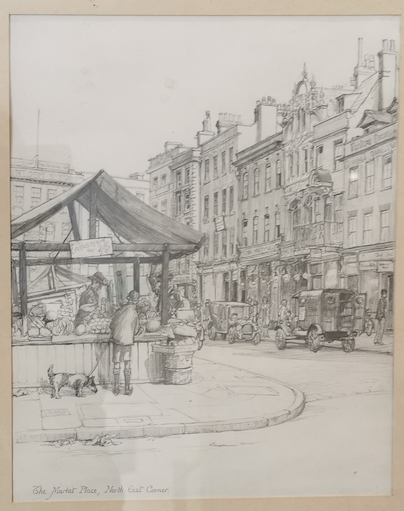
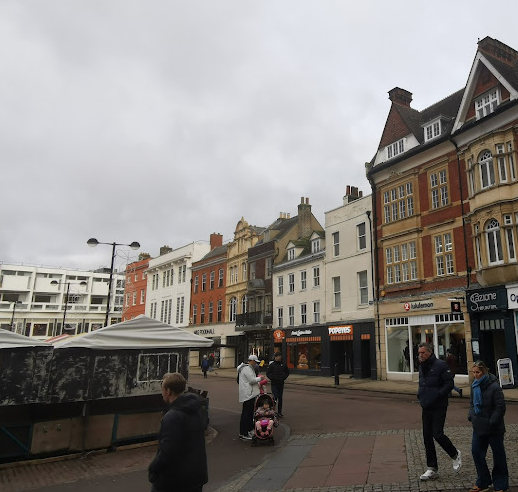
16/8/1912 A meeting of the Women’s Social and Political Union was being held and soon after Miss Kathleen Jarvis began her speech the bells of Great St Mary’s struck up a deafening peal. The fair speaker’s voice, pleasing but not powerful, was almost completely lost and it was only by her gesticulations that the crowd could see she was still expounding her principles. For something like an hour the unequal contest was maintained. And Miss Jarvis was the winner. A woman who had earned three periods of imprisonment was not to be daunted and was still pouring out a stream of argumentative bullets when the ringers retired (Cam.News)
Butter in Cambridge was sold by the yard until the First World War when rationing was introduced. The market stall of Mr J Hopkins of Stretham sold butter this way.
12/12/1912
Cambridge Suffragettes damn the Liberals as Frauds in Market Hill open meeting. 1912.
20/11/1918 Armistice Celebrated. Cambridge “let itself go” with full vigour on November 11 on receipt of the news that the Germans had accepted and signed the drastic armistice terms of the Allies, and the rejoicings were kept up on every evening throughout the week. The effigy of the Kaiser was hoisted on the point of a bayonet and carried through the streets, to be consigned to the flames of a Market Hill bonfire one evening. A cadet, attired as a padre, attended to the “obsequies”. Later processions of cadets met on the Market Hill engaged in a Big Push. Premises occupied by the “Cambridge Magazine” at the corner of St. John’s Street were wrecked by a crowd. Two other shops in the same occupation were treated in similar fashion Alleged German guns on view Market Hill; these samples of scrap iron should be consigned rubbish heap (Cam.News)
10/9/1919 Cattle market as now conducted is of no value to town … a waste of expensive shoe leather. Previously could purchase a fowl or duck ready for table at a reasonable price, the Cambridge ‘yard’ of butter, eggs, fruit, meat etc. Now a dump for where high prices are rule. Patrons are those fairly comfortable who desire freshly-produced vegetables and are prepared to pay for them at prices dearer than in shops. On Saturday was fairly brisk competition in fish, meat stalls doing food business. An open market is wanted every day on Market Hill to bring down prices and dispose of tons of produce which will otherwise go rotten. Are already hawkers of fruit and vegetables. During trade depression some traders had a hard struggle; employees now coming back but require more wages to meet the rising cost of living. Fair competition doesn’t cause anxiety but the open market is unfair. They buy wholesale, dire a stall for a negligible sum and sell at small margin of profit – debate – (Cam.News)
23/4/1919 Captured German Guns. Two captured German field guns are being exhibited on the Market Hill Cambridge but are however attracting comparatively little attention (Cam.News)
10/11/1922 Armistice Day – Remembrance Day as many people prefer to call it – once again comes round tomorrow. The occasion will be observed with all the solemnity of former years by all, not excepting the exuberant spirits who will participate in a promised ‘Varsity “rag” for they will hold their noise at 1 lam and join with the rest in the two minutes’ silence which will ensue throughout the country. The “rag” will take the form of a “circus”. Undergraduates will be attired in the skins of wild animals. It is rumoured that the effigy of the ex- Kaiser will be burnt at the stake on Market Hill in the evening! (Cam.News)
11/11/1922 As in every other town and village throughout the land the Two Minutes Silence was observed in Cambridge today. In the streets traffic was stopped by the police and pedestrians stood just where they were when the first maroon went off. Market Hill was densely crowded and as the Guildhall clock started to chime men stood to attention and removed their hats, all movement ceased and the traffic stopped. The only sounds to be heard were the crying of one or two babies. Shortly before the second maroon a shuffling step was heard coming slowly along the Cury, a few turned their heads and saw an old man who, apparently oblivious, kept on his way undisturbed until a penetrating hiss: “Stand still, Beaver!” brought him back to this world and he stood with the rest of mankind (Cam.News)
17/8/1923 A meeting was held on Cambridge Market Hill under the auspices of the local branch of the World’s League Against Vivisection. Some hundreds gathered around the first speaker who was heard amid a running series of questions and interruptions. He gallantly held his post for over an hour, and many of his points were agreed to, even by opponents of the movement generously. Certain diseases had been lowered doing the last 50 years in response to sanitary improvements, he said, but no direct evidence could be found as to any decrease of the death rate as a result of vivisection. (Cam.News)
9/3/1925 The bright idea was to unveil a ‘statue’ of Eros on Cambridge Market Hill, but they did not appear till quite three-quarters of an hour late. The crowd got tired of waiting and certain of their number pelted some adventurous spirits perched on the Market cross with oranges, and this little incident led to a general exchange of soft and ‘squashy’ fruit. Oranges gave place to tomatoes, which were followed by eggs and bags of flour. Besides being unpleasant, practice of this sort is dangerous. (Cam News)
1/12/1925 Sir – The scenes on Sunday night in Petty Cury & Market Hill, Cambridge are disgraceful. Low hobbydehop youths and flat-chested flappers congregate and parade, whistling and shouting after each other and using language that would shame Billingsgate. Surely the police can put an end to such disgraceful proceedings – A.E.C. (Cam.News)
15/6/1926 One of the contingents of Women Peacemakers who are converging on London from various parts of the country arrived in Cambridge. Meetings had been held in village after village by the side of the war memorials. They were met by members of the local Pilgrimage Committee and proceeded to the Market Hill where an impromptu meeting was held. They carried various banners and red and blue flags. Mrs Rackham said the gathering recalled the great Women’s Suffrage Pilgrimage of 1913 when crowds gathered on the same spot. The Pilgrims leave for Saffron Walden tomorrow. (Cam.News)
7/9/1926 A vivid flash followed by a terrific explosion occurred last night and at about the same time various people in Cambridge declare that they, too, saw a peculiar flare in the sky. No noise was heard. A police constable described the flash as lasting from five to six seconds and as making it appear as bright moonlight. Miss G. Gould, who was in charge of the coffee stall on Market Hill, said the whole of the sky in the south was lit up for about five seconds by a blue flame. A member of the “Stop! Look! and Listen” company said she noticed a vivid flash from her dressing room window. (Cam.News)
9/6/1927 Cambridge Undergraduates took upon themselves the duty of opening “Joanna Southcott’s” famous box on the Market Hill. A crowd of mammoth proportions assembled. A melancholy dirge was heard from Petty Cury and there appeared a party of pipers and following them in one of Dale’s lorries came a weird array of 24 “bishops” and a delegation of “Mormons” wearing huge straw sombreros. One “archbishop” proceeded to open the box, producing several layers of red tape, a teddy bear, a pair of old football boots and a number of bananas with which he pelted the crowd. The “rag” was organised to provide funds for the Cambridge Fruiting Campaign to help strawberry pickers in the Wisbech area. (Cam.News)
10/1/1928 An inquiry was held into proposals to alter the charges for stalls on Cambridge market. There were 112 stalls, 64 of which were interior stalls but some, particularly those at the four corners of the market were more valuable than others. The present charge was 2s. 6d. per day and it was proposed to increase it to 6s. 10s for corner stalls, with frontage stalls increased to 4s.8d and the interior stalls raised to 3s. 4d. But the proposals had not been received with enthusiasm by the traders. (Cam.News)
27/10/1928 There is much speculation regarding the £42,000 Cambridge Market Hill deal; a large cinema and cafe are spoken of, but there are no details at present. It would be for the benefit of the town if the whole island site could be taken over by the Corporation; then as the leases run out it could be cleared and would provide a magnificent site for municipal buildings. Road traffic now demands that all building operations should be planned for what will be needed in the future, with a wider Petty Cury, Market Hill and Sidney Street. Something of the sort must eventually be done unless it is the intention to remove the Guildhall and market nearer the station. (Cam.News)
20/11/1928 Earlier we gave details of a £42,000 deal in Cambridge Market Hill; now we can reveal proposals to build a super Victoria Cinema that will accommodate about 1,800 people and embody all the latest improvements with the most comfortable seating and an excellent orchestra. Large waiting lounges will be included to accommodate all queues in the building and protect patrons from the weather. A luxurious cafe restaurant is also promised. We are unable to state whether apparatus for ‘talkies’ will be included but no doubt if this art develops sufficiently well in time this new asset will not be overlooked. (Cam.News)
25/2/1930 Sir – we Cambridge market traders notice that Councillor Longley wants to move our stalls into the Corn Exchange but we challenge him to produce a transferred market that has been a success. He wants to replace the stalls with car parking spaces. Cannot he see the utter foolishness of congesting the very centre of a town with cars. Those on Market Hill consist of business townsmen, clerics and travellers who sit in their expensive car, eat bread and cheese, beg an onion to go with it but do little business. The Market Hill and Peas Hill are open-air markets. An arcade was tried years ago. The building stands today, a sorry sight, in St Andrew’s Hill. The stallholders all failed – W.J. Sambridge. (Cam.News)
27/12/1930 The heavy rain did not deter a large number of members of the Cambridgeshire Hunt from assembling on Cambridge Market Hill for this traditionally English spectacle. The scene was one worth a soaking to witness. Figures in the traditional red and black mingled with macintoshed horsemen, their steaming mounts were restless, the hounds silent and around was a rain-drenched crowd of about 1 ,000 people. They took a great deal of interest in a small terrier who looked out from the mouth of a haversack slung across a red-coated huntsman’s back. (Cam.News)
23/1/1936 Several thousand packed Cambridge Market Hill where from a special platform draped in purple the new King Edward VII was proclaimed. But proceedings were interrupted by the appearance overhead of an aeroplane and as a result of the noise from the engine the Mayor (Aid Wing) had to pause. Undergraduates crowded outside the Senate House where the University ceremony was held. Many of them had cameras and four or five, determined to get a good view of the ceremony, climbed into the huge bowl which stands on a pedestal in the court. (Cam. News)
1938 John Shepperson of Swavesey writes abut his recollections of Cambridge Market in Memory Lane (2004), Swavesey History Society.
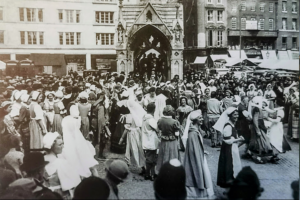
Dancing before the Tudor Fair, 27.4.1938, which took place at the Corn Exchange to raise money for the Harvey Goodwin Home.
7/10/1938 William Coad of Cavendish Avenue has come up with an answer to the need for underground A.R.P. shelters. His scheme is to construct a sub-way car park underneath Cambridge Market Square with inlet and outlet ramps, which, in the event of an emergency, could be converted into an effective shelter accommodating several thousand people. A nominal car-parking fee would eventually pay for the initial outlay and alleviate the need for suitable garaging for business men coming into the town. (Cam.News)
It was a scene that Louis Cobbett set out to capture for the Cambridge Antiquarian Society’s Photographic Record in 1938. Dominating the centre of the Market Square was an ornate fountain that had replaced the old Hobson’s Conduit in 1856 following a fire that had swept the area. Those buildings not razed to the ground had been removed to create the square market place we know today. The fountain proved a magnet for undergraduate climbers during numerous ‘rags’ and bonfires but by 1953 the stonework was in poor condition and the ornate canopy was removed. Some of the stone figures were placed in the Museum of Cambridge, leaving the base of the fountain in situ. (Mike Petty Fenland History)
11/11/1938 Undergraduates invaded the streets, skilfully extracting all the spare coppers with various ingenious stunts. In white sweaters and kilts of many clans the University Pipe Band paraded to Market Square for a display of Highland dancing, then toured public houses. The ‘Peace Group’ were perched on a cart disguised as a camouflaged tank decorated with “Atlee’s pants” – which appeared to be pale pink in colour. Standing on the tank were two dictatorial-looking figures in uniform. Amongst the individual performers was a man on a pair of stilts made from sculls while barrel-organ players were dressed as ghosts (Cam. News)
1941 Jack Overhill recorded in his diary for March 6th 1941:
There was a warning today at 12.45 pm lasting till 2.15 pm. Soon after the Alert I hear a bomber go over and went to the door of the shop to have a look at it…. shortly afterwards two fighters whizzed past in the same direction …. in the paper tonight the report said it machine-gunned the Market Square and a woman was injured…
1944 Jack Overhill wrote 10.11.1944:
There’s been a lot of ‘to-do’ about ‘rag’ by students in the town on Guy Fawkes Day. It was a bit unexpected. They had a bonfire on Market Hill, turned over car, smashed bus windows, fought policemen, etc, and the affair got into the London dailies.
A lot of correspondence was generated in the Cambridge Daily News at the time.
8/5/1945 VE celebrations, Market Square, crowd of several thousand, waste paper dump in St Mary’s Passage set on fire, cars and stalls damaged, flag on top fountain, climb Guildhall clock (Cam.News)
1946 Award by the Mayor Lady Alice Bragg of Freedom of the Borough of Cambridge to the Cambridgeshire Regiment after their return from captivity in the Far East in WWII.
#VJDay75 and the return of the survivors of the Cambridgeshire Regiment
1953
The pinnacles were removed from the fountain in the middle of the market. They are now in the yard of the Museum of Cambridge.
2021
See also:
2022
Contribute
Do you have any information about the people or places in this article? If so, then please let us know using the Contact page or by emailing capturingcambridge@
License
This work is licensed under CC BY-NC-SA 4.0





